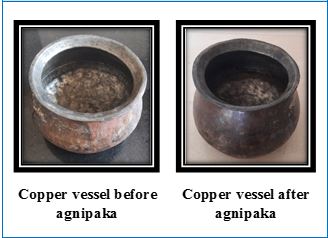Comparative pharmaceutical and analytical study of Kasisadi Ghrita prepared by two different methods
DOI:
https://doi.org/10.21760/jaims.7.10.19Keywords:
Ayurveda, Bhanupaka, Comparative Study, Herbomineral, Kasisadi Ghrita, Sneha Kalpana.Abstract
Introduction: Sneha Kalpana are the dosage forms which can be used both internally as well as externally. Generally, Sneha Kalpana is prepared by using Agni as source of heating. However, Kasisadi Ghrita is an exception where the sunlight is used as source of heating. This unusual method of preparation looks attractive because of natural heat (sunlight) that is required in the preparation and the yield that may be obtained. The Sneha is heated with volatile drugs in Surya Paka for a specific time so that less heat allows them to leave their active principles in Sneha. The difference between Bhanupaka and Agnipaka is also an area of interest, on this formulation as far as its manufacturing is considered. Kasisadi Ghrita is a herbo-mineral formulation indicated for various skin diseases. Materials and Methods: Kasisadi Ghrita were prepared by classical method of Bhanupaka (KGB) and usual method of Agnipaka (KGA). Both KGB and KGA were analyzed as per the standard protocol. Discussion and Conclusion: Preparation of Kasisadi Ghrita by Agnipaka method is easy as it consumes less time. There were no pharmaceutical constraints in preparation of both samples. Tamra Paatra helps to retain more heat than other vessels during Bhanupaka. The results of the pharmaceutical and analytical study can be considered as the preliminary standards for the preparation of Kasisadi Ghrita.
Downloads
References
Acharya J T. Charaka Samhita. Reprint ed. Varanasi: Chaukhambha Orientalia; 2011. p.120.
Shastri Ambikadutta. Susruta Samhita. Reprinted ed. Varanasi: Chaukhambha Sanskrit Sansthan; 2005. p.133.
Murthy Srikantha. Ashtanga Hrudaya. Nineth ed. Varanasi: Chaukhambha Sanskrit Series; 2013. p.208.
Angadi R. A Textbook of Bhaishajya Kalpana Vijnana. Second revised ed. Varanasi: Chaukhamba Sanskrit Pratishthan; 2016. p.250-59.
Kishore Prem. Abhinava Chintaamani. First ed. New Delhi: Central Ayurveda and Siddha Research Center; 1999. p.176.
Rang Sourav Kumar, Sharma Govinda K, Saokar Reshma, Kadibagil Vinay R, Loganathan Sorunini. Review on Adityapaka- Sneha Kalpana. UJAHM. 2016; 04 (06): 22-24. Available from:
Srikantha Murthy K R, English translation on Sharangadhara Samhita of Acharya Sharangadhara. First ed. Madhyama kanda; Sneha Kalpana adhyaya: Chapter 9, Verse 51-54. Varanasi: Chaukamba Orientalia, 2017. p.120-21.
Monier Williams. Sanskrit- English Dictionary. Varanasi: Indica Books; 1996. p.755.
Anonymous. The Ayurvedic Formulatory of India. Second ed. CCRAS. New Delhi: Ministry of Health and Family Welfare, Govt. of India; 2003. part I. vol I: p.83.
Anonymous. The Ayurvedic Pharmacopeia of India. First ed. Dept of AYUSH. New Delhi: Ministry of Health and Family Welfare, Govt. of India; 2009. part II. vol II: p.280.
Anonymous. The Ayurvedic Pharmacopeia of India. First ed. Dept of AYUSH. New Delhi: Ministry of Health and Family Welfare, Govt. of India; 2008. part II. vol I: p.253.
Anonymous. The Ayurvedic Pharmacopeia of India. First ed. Dept of AYUSH. New Delhi: Ministry of Health and Family Welfare, Govt. of India; 2008. part II. vol I: p.252.
Anonymous. The Ayurvedic Pharmacopeia of India. First ed. Dept of AYUSH. New Delhi: Ministry of Health and Family Welfare, Govt. of India; 2008. part II. vol I: p.251.
Kasinada Shastri, editor, (reprinted ed.). Commentary on Rasatarangini of Sadananda Sharma: Chapter 21, Verse 107. Varanasi: Choukhamba Orientalia, 2000. p.540.
Hegde PL, Harini A. A textbook of Dravyaguna Vijnana. Revised ed. Varanasi: Chaukhambha Sanskrit Sansthan; 2020. Vol II. p.266.
Murthy Srikanta. Sharangadhara Samhita. Fourth ed. Varanasi: Chaukhambha Orientalia; 2001. p.115.
Sharangadhara, Adhamalla. Pandit Kashirama. Sharangahara Samhita Dipika Gudartha Dipika. Seventh ed. Varanasi: Chaukhambha Orientalia;2008. p.213.
CCRAS. Laboratory Guide for the Analysis of Ayurveda and Siddha Formulation. First ed. Dept of AYUSH. New Delhi: Ministry of Health and Family Welfare, Govt of India; 2010. p.16.
Food safety and Standards Authority of India. Manual of method of analysis of foods- oils and fats. New Delhi: Ministry of Health and Family Welfare, Government of India; 2015. p.9-28.
Radhakrishna Parasara, editor. Fourth ed. Sharangadhara Samhita of Acharya Sharangadhara. Madhyama Khanda; Chapter 6, Verse 6. Nagpur: Shree Baidyanatha Ayurveda Bhavana; 1994.















